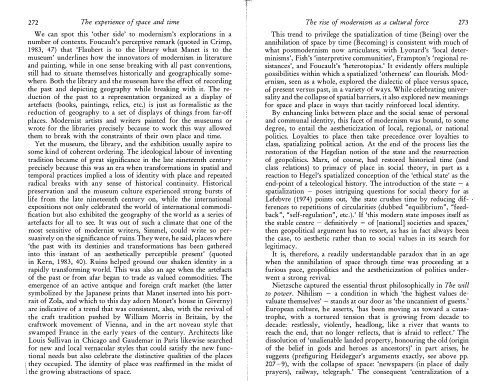The Condition of Postmodernity 13 - autonomous learning
The Condition of Postmodernity 13 - autonomous learning
The Condition of Postmodernity 13 - autonomous learning
Create successful ePaper yourself
Turn your PDF publications into a flip-book with our unique Google optimized e-Paper software.
272 <strong>The</strong> experience <strong>of</strong> space and timeWe can spot this 'other side' to modernism's explorations in anumber <strong>of</strong> contexts. Foucault's perceptive remark (quoted in Crimp,1983, 47) that 'Flaubert is to the library what Manet is to themuseum' underlines how the innovators <strong>of</strong> modernism in literatureand painting, while in one sense breaking with all past conventions,still had to situate themselves historically and geographically somewhere.Both the library and the museum have the effect <strong>of</strong> recordingthe past and depicting geography while breaking with it. <strong>The</strong> reduction<strong>of</strong> the past to a representation organized as a display <strong>of</strong>artefacts (books, paintings, relics, etc.) is just as formalistic as thereduction <strong>of</strong> geography to a set <strong>of</strong> displays <strong>of</strong> things from far-<strong>of</strong>fplaces. Modernist artists and writers painted for the museums orwrote for the libraries precisely because to work this way allowedthem to break with the constraints <strong>of</strong> their own place and time.Yet the museum, the library, and the exhibition usually aspire tosome kind <strong>of</strong> coherent ordering. <strong>The</strong> ideological labour <strong>of</strong> inventingtradition became <strong>of</strong> great significance in the late nineteenth centuryprecisely because this was an era when transformations in spatial andtemporal practices implied a loss <strong>of</strong> identity with place and repeatedradical breaks with any sense <strong>of</strong> historical continuity. Historicalpreservation and the museum culture experienced strong bursts <strong>of</strong>life from the late nineteenth century on, while the internationalexpositions not only celebrated the world <strong>of</strong> international commodificationbut also exhibited the geography <strong>of</strong> the world as a series <strong>of</strong>artefacts for all to see. It was out <strong>of</strong> such a climate that one <strong>of</strong> themost sensitive <strong>of</strong> modernist writers, Simmel, could write so persuasivelyon the significance <strong>of</strong>'ruins. <strong>The</strong>ywere, he said, places where'the past with its destinies and transformations has been gatheredinto this instant <strong>of</strong> an aesthetically perceptible present' (quotedin Kern, 1983, 40). Ruins helped ground our shaken identity in arapidly transforming world. This was also an age when the artefacts<strong>of</strong> the past or from afar began to trade as valued commodities. <strong>The</strong>emergence <strong>of</strong> an active antique and foreign craft market (the lattersymbolized by the Japanese prints that Manet inserted into his portrait<strong>of</strong> Zola, and which to this day adorn Monet's house in Giverny)are indicative <strong>of</strong> a trend that was consistent, also, with the revival <strong>of</strong>the craft tradition pushed by William Morris in Britain, by thecraftwork movement <strong>of</strong> Vienna, and in the art noveau style thatswamped France in the early years <strong>of</strong> the century. Architects likeLouis Sullivan in Chicago and Gaudemar in Paris likewise searchedfor new and local vernacular styles that could satisfy the new functionalneeds but also celebrate the distinctive qualities <strong>of</strong> the places\ they occupied. <strong>The</strong> identity <strong>of</strong> place was reaffirmed in the midst <strong>of</strong>\ the growing abstractions <strong>of</strong> space.<strong>The</strong> rise <strong>of</strong> modernism as a cultural force 273This trend to privilege the spatialization <strong>of</strong> time (Being) over theannihilation <strong>of</strong> space by time (Becoming) is consistent with much <strong>of</strong>what postmodernism now articulates; with Lyotard's 'local ,determinisms',Fish's 'interpretive communities', Frampton's 'regional resistances',and Foucault's 'heterotopias.' It evidently <strong>of</strong>fers multiplepossibilities within which a spatialized 'otherness' can flourish. Modernism,seen as a whole, explored the dialectic <strong>of</strong> place versus space,<strong>of</strong> present versus past, in a variety <strong>of</strong> ways. While celebrating universalityand the collapse <strong>of</strong> spatial barriers, it also explored new meaningsfor space and place in ways that tacitly reinforced local identity.By enhancing links between place and the social sense <strong>of</strong> personaland communal identity, this facet <strong>of</strong> modernism was bound, to somedegree, to entail the aestheticization <strong>of</strong> local, regional, or nationalpolitics. Loyalties to place then take precedence over loyalties toclass, spatializing political action. At the end <strong>of</strong> the process lies therestoration <strong>of</strong> the Hegelian notion <strong>of</strong> the state and the resurrection<strong>of</strong> geopolitics. Marx, <strong>of</strong> course, had restored historical time (andclass relations) to primacy <strong>of</strong> place in social theory, in part as areaction to Hegel's spatialized conception <strong>of</strong> the 'ethical state' as theend-point <strong>of</strong> a teleological history. <strong>The</strong> introduction <strong>of</strong> the state - aspatialization - poses intriguing questions for social theory for asLefebvre (1974) points out, 'the state crushes time by reducing differencesto repetitions <strong>of</strong> circularities (dubbed "equilibrium", "feedback","self-regulation", etc.).' If 'this modern state imposes itself asthe stable centre - definitively - <strong>of</strong> [national] societies and spaces,'then geopolitical argument has to resort, as has in fact always beenthe case, to aesthetic rather than to social values in its search forlegitimacy.It is, therefore, a readily understandable paradox that in an agewhen the annihilation <strong>of</strong> space through time was proceeding at afurious pace, geopolitics and the aestheticization <strong>of</strong> politics underwenta strong revival.Nietzsche captured the essential thrust philosophically in <strong>The</strong> willto power. Nihilism - a condition in which 'the highest values devaluatethemselves' - stands at our door as 'the un canniest <strong>of</strong> guests.'European culture, he asserts, 'has been moving as toward a catastrophe,with a tortured tension that is growing from decade todecade: restlessly, violently, headlong, like a river that wants toreach the end, that no longer reflects, that is afraid to reflect.' <strong>The</strong>dissolution <strong>of</strong> 'unalienable landed property, honouring the old (origin<strong>of</strong> the belief in gods and heroes as ancestors), in part arises, hesuggests (prefiguring Heidegger's arguments exactly, see above pp.207-9), with the collapse <strong>of</strong> space: 'newspapers (in place <strong>of</strong> dailyprayers), railway, telegraph.' <strong>The</strong> consequent 'centralization <strong>of</strong> a
















